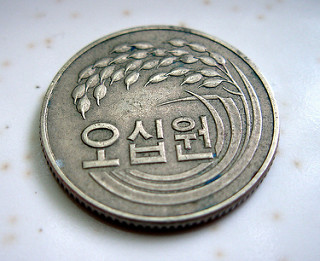Archive by Author
Korean Counters Posted by Soo on Nov 10, 2014
In the previous week, you learned Native-Korean number and how to use the number with Korean currency Won. Let’s learn more detail how to use the number with counters: 명/myung/is a counter for people. You should be noticed that number 1 to 4 and 20 have been changed to another form below. 1/하나/hana 한 명/han…
Native-Korean Number Posted by Soo on Nov 3, 2014
As I mentioned before there are two Korean numbers which are Sino-Korean number and Native-Korean number. There are only from 1 to 99 numbers in Native Korean number and it is used to count hours, age, people, and objects. Let’s learn 1 to 10 first and 20, 30, 40, 50, 60, 70, 80, and 90…
Korean Sino & Currency Posted by Soo on Oct 27, 2014

In the previous week, you learned Sino-Korean number from 1 to 99. In this week, you will learn bigger numbers and counter for Korean currency (Won). 100 is 백/baek. 1000 is 천/choen. 10,000 is 만/man. 100,000 is 십만/sip man. 1,000,000 is 백만/baek man. Let’s practice how to conjugate these big numbers. 5 x 100 =…
Sino-Korean Number Posted by Soo on Oct 20, 2014
There are two kinds of number in Korea. In this week, you will learn Sino-Korean number. What is Sino by the way? Sino means china; Sino-Korean word is Chinese character. Korean has used one’s own speaking language but they didn’t have their own letters for a long time. Therefore, Korean still uses Sino number. Let’s study…
Learning Korean Suffixes Posted by Soo on Oct 13, 2014

In the previous week, you learned Korean ending verb; “How is (it)?/ (이/가) 어때요?/(e ga) eo ddae yo?” In this week, you will learn how to answer the question. 아요/어요/해요/a yo/eo yo/ hae yo is verb ending suffix. You can add these verb suffixes after infinitive of action and descriptive verbs. You can add 아요…
Learning Useful Phrase Posted by Soo on Oct 6, 2014
This week you will learn Korean ending verb; “How is (it)?/ (이/가) 어때요?/(e ga) eo ddae yo?” This phrase is very useful for beginners. You would use this expression to be friendly to your friends and people. Let’s make some sentences with using vocabularies below. 이/가 is subject particles you can add right after nouns…
How to say “it is” in Korean Posted by Soo on Sep 22, 2014

Usually after you learned greeting in Korean, the next step would be asking something “what is (it)/뭐예요/meo ae yo.” Through this question, you will memorize many kinds of words because you need to answer. I usually teach loan words first, so my students can get used to Korean sound value. For instance: it is a…


